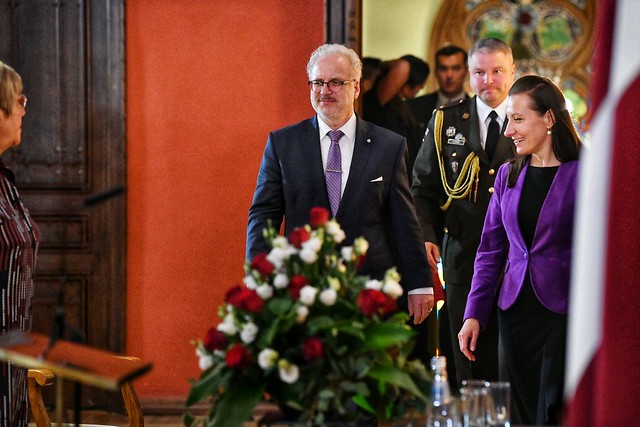Honourable Madam Speaker,
Former speakers, commentators, ladies and gentlemen,
I want to say a big, big thank you to everyone who helped publish the constitutional comments. For the first time ever, Latvia will now have a full set of constitutional comments on all articles of our constitution, the Satversme, starting with Article 1, all the way up to Article 116. The comments reflect the theoretical and practical approaches. There is no dividing line between theory and practice because practitioners are supposed to follow best practices suggested by theoreticians. If a verdict or government decision fails to live up to standards accepted in legal science, it cannot be considered lawful. On the other hand, scholars who are responsible for development of legal science are, of course, obliged to think about applicability of their standpoints instead of giving only abstract guidelines. Scholars should give the line of reasoning that may be useful in specific cases. These comments have a two-fold role: provide theoretical input, of course, and also give practical guidance on how to deal with future parliamentary challenges.
These comments reaffirm our commitment to a particular legal space. We are a part of the continental European legal system where such comments are traditional. We belong to a particular part of it, the Central and Eastern European region, where constitutional comments have huge effect on practices. If you break European continental law into sub-regions, there are three distinct regions: Central and Eastern Europe, and also Northern Europe, where constitutional comments carry a lot of weight; French-speaking, where comments still carry weight, but it is slightly less significant; and Southern European, where comments have some weight, but it is not as significant as here. This confirms our integration into the common legal space and also shows how much our legal science doctrines and practices are aligned. There are not that many countries, which use constitutional comments. For example, Estonia and Lithuania have none, Poland has constitutional comments, but there are only two or three volumes. So, their scope is smaller. Germany, of course, is the gold standard for constitutional comments, and we are almost at the same level as they are. Swiss and Austrian constitutional comments are also as developed. This is one of the traits that put sus among countries forming a continental European law area, a modern legal space.
Comments reflect the debate and various interpretations of constitutional norms. As Madam Speaker already pointed out, these interpretations are crucial. Interpretation contributes to openness of the text. There is no term or notion that can be closed off, explicitly defined for ever more. You can hypothetically do that with numbers. If I say ‘five’, there is very little room for alternative interpretations, although I know that there are many mathematicians still arguing as to what ‘five’ would exactly imply. But, if we leave numbers aside, there is always room for interpretation. And, as far as these comments are concerned, the interaction between commentators and those interpreting their views. Sometimes commentators become the ones who also interpret the texts. That is often the case with Saeima, which is required to also give interpretation of its decisions. However, mostly these roles are, of course, more apart from each other. In our case, government, civil service, courts, Constitutional court are the main target group of these comments, but there is also another important group, the citizens. People must be aware of their constitutional rights given to them by Satversme. And this is the way to give citizens a very detailed and nuanced interpretation of various norms included in our constitution. You can read the text of the constitution, which is a rather thin little book, in literally minutes, but it takes about six volumes to tell you what it all really means. And today we are presenting the last of these six volumes. It does not, of course, describe every instance, and that is why these comments are an open text. Comments establish standards that open the way for interpretations and then, of course, these standpoints are developed through practice and legal theories. Without these comments, their reasoning would be less straightforward.
I would also like to mention another reason why constitutional comments carry much more weight in our, European continental law, compared to, let us say, Anglo-Saxon law or other legal systems. I am talking about the so-called common sense or judges using their common sense as a legal tool. They must, of course, follow what legislature has decided, but they must also follow their common sense. Such way of interpretating has its strengths and also weaknesses. On the plus side, it allows to directly go to most adequate option in the particular case in terms of justice. But the downside of such approach is that it may indicate towards lack of efficient reform instruments, potential for change and development at national level because common sense is needed to reflect on past precedents. It is not meant to be forward-oriented as much in terms of what we want to see in our democratic system. That is why the law defines the national development ever since the French revolution 200 years ago. Law allows us to reform the traditions and what our common sense dictates, and it also reflects the kind of future we are looking to build. In our case, these comments reflect the intentions of the legislature at the moment it made the law and also the vision of commentators on the way one or another matter should be decided and governed, which is also extremely valuable. Comments are not detached from the author, but they are also not chained to author’s views. I mean, the proposals of the Constitutional Court dating back to 1922. That is why these comments keep evolving and contributing to our national development.
These comments, of course, did not appear out of thin air. There is a man who conceived the idea and took the project all the way to this moment. And his name is Professor, Dr. iur. Ringolds Balodis. Mr Balodis has also had an opportunity to see what makes the institution so eloquently discussed in these comments tick. I assume that his parliamentary experiences had some kind of impact on the content of the comments on particular sections. It is crucial to see both sides, and not everybody is lucky enough to experience that. And that, of course, only adds value to these comments.
I would like to thank all commentators because their thoughts will have major impact on legal science and practices. Constitutional court, courts of other instances, public institutions, government departments, civil servants, local municipalities and also, as Madam Speaker mentioned, the Saeima itself, and, last but not least, citizens will often turn to these comments to get a better insight into how this country is run and maybe even come to understand what needs to be changed if they see that something does not work the way it should.
I want to say a special thank you to scientific editor, Mr Ringolds Balodis, and chief publishing editor, Mrs Daina Ābele, for completing this mammoth task, and present the Presidential plaquette awarded to anyone president deems worthy of such recognition due to their notable contribution to development of our nation.
Commentators of ‘Comments on the Constitution of the Republic of Latvia, Satversme, Chapter II: Parliament, Saeima’ include Laila Jurcēna, Deputy Head of the Chancery of the President of Latvia, and Jānis Pleps, Legal Policy Adviser to the President of Latvia. Mr Pleps was also the member of book’s scientific-editorial team.





